AI Religion
Tools:
Advisor:
Date:
Blender
Figma
ChatGPT
Procreate
Figma
ChatGPT
Procreate
Tanuja Mishra
March - June 2023
Brainstorm
What is Speculative Design?
Speculative Design =
Design a world in the near or far future +
Design a product, service or system for that world

Personal Conjecture
What if there is a future product that can unlock full potential of human brain?
What is the meaning of transcending human limitations in the far future?
What is the meaning of transcending human limitations in the far future?
II’m always interested in observing how people with different personalities think and behave, resulting in various consequences. No matter how far into the future, all products/services/systems should remain human-centered. Thus, instead of discovering how the world will be, this project transit from an individual scale to a broader context.
WORLD based on PRODUCTS/SERVICES/SYSTEMS based on HUMAN BEHAVIOR
Critical Reflection
Current Reality:
Brain wave detection, big data personalized contents.
Brain wave detection, big data personalized contents.
Potential Impact:
AI can revolutionize technology interactions by translating brain signals into readable words and providing personalized recommendations.
AI can revolutionize technology interactions by translating brain signals into readable words and providing personalized recommendations.
Concerns:
Privacy and data security, intensifying inequalities between wealthy and poor individuals.
Privacy and data security, intensifying inequalities between wealthy and poor individuals.
Inclusivity:
Diverse development teams, accessible technology in various settings, gathering feedback from diverse users, considering cultural backgrounds in AI advice.
Diverse development teams, accessible technology in various settings, gathering feedback from diverse users, considering cultural backgrounds in AI advice.
Research
Interest Triad
Personality test, such as MBTI.
AI impact in people daily life
Different kinds of BCI in daily application.
PESCTLEE
BCI combining with AI
Political
Regulatory Framework: Governments around the world are working on regulations for BCIs and AI, addressing issues like privacy and data security. eg. The EU's General Data Protection Regulation (GDPR) applies to BCI and AI systems that process personal data.
Regulatory Framework: Governments around the world are working on regulations for BCIs and AI, addressing issues like privacy and data security. eg. The EU's General Data Protection Regulation (GDPR) applies to BCI and AI systems that process personal data.
Economic
Market Growth: The BCI and AI industry is experiencing rapid growth, creating economic opportunities. Companies like Neuralink, a BCI startup founded by Elon Musk, are attracting substantial investments.
Market Growth: The BCI and AI industry is experiencing rapid growth, creating economic opportunities. Companies like Neuralink, a BCI startup founded by Elon Musk, are attracting substantial investments.
Social
Accessibility and Inclusivity: BCIs combined with AI might be able to improve the quality of life for disabled people. eg. Brain-Computer Interfaces can enable paralyzed individuals to control devices or communicate, promoting social inclusion.
Accessibility and Inclusivity: BCIs combined with AI might be able to improve the quality of life for disabled people. eg. Brain-Computer Interfaces can enable paralyzed individuals to control devices or communicate, promoting social inclusion.
Cultural
Changing Perceptions: The acceptance of BCIs might vary across cultures. In some cultures, the integration of BCIs for tasks like cognitive enhancement may be easier to accept than in others.
Changing Perceptions: The acceptance of BCIs might vary across cultures. In some cultures, the integration of BCIs for tasks like cognitive enhancement may be easier to accept than in others.
Technological
Neurofeedback for Mental Health: BCIs and AI can be used for neurofeedback therapy, helping individuals manage conditions like anxiety and ADHD. Advanced AI algorithms can analyze brain activity and offer personalized feedback.
Neurofeedback for Mental Health: BCIs and AI can be used for neurofeedback therapy, helping individuals manage conditions like anxiety and ADHD. Advanced AI algorithms can analyze brain activity and offer personalized feedback.
Legal
Intellectual Property: Protecting intellectual property related to BCIs and AI is a legal challenge. Companies and researchers need to improve legal mechanisms to protect their inventions.
Intellectual Property: Protecting intellectual property related to BCIs and AI is a legal challenge. Companies and researchers need to improve legal mechanisms to protect their inventions.
Environmental
Energy Consumption: Energy-efficient designs and sustainable materials are important for mitigating environmental concerns while BCI and AI might need some power-hungry devices.
Energy Consumption: Energy-efficient designs and sustainable materials are important for mitigating environmental concerns while BCI and AI might need some power-hungry devices.
Ethical / Moral
Privacy Concerns: The use of BCIs and AI for accessing brain data can raise ethical questions about privacy and consent which might lead to inequalities between wealthy and poor people.
Privacy Concerns: The use of BCIs and AI for accessing brain data can raise ethical questions about privacy and consent which might lead to inequalities between wealthy and poor people.
Technology Research




- Open BCI: an open-source project that aims to develop affordable and accessible tools for measuring and analyzing brain activity. Their products include EEG headsets and software that can be used for research and personal use.

- DeepMind is an artificial intelligence company owned by Google that specializes in deep learning and reinforcement learning algorithms. They have made significant advancements in using AI to interpret brain signals and predict behavior.


- Necomimi: Headset Model Lightweight Brain waves signaled by cat's ear movement and voice
- MBTI Personality Test: self-report questionnaire indicating differing psychological preferences in how people perceive the world and make decisions.

- CliftonStrengths: an online personality-assessment tool that focuses on 34 themes that make up the user's personality.

- University of Washington researcher Rajesh Rao, left, plays a computer game with his mind. Across campus, researcher Andrea Stocco, right, wears a magnetic stimulation coil over the left motor cortex region of his brain. Stocco's right index finger moved involuntarily to hit the "fire" burton as part of the first human brain-to-brain interface demonstration. University of Washington.

- Chat GPT: an AI assistant designed to help with a wide range of topics and engage in conversation with users

- Midjourney: a generative artificial intelligence program and service created and hosted by San Francisco-based independent research lab Midjourney, Inc.

Ideate the future
What-if question
Consider a world where AI can digitally store an individual's consciousness, and reveal hidden memories or thoughts that a person is consciously unaware of.
What if people unquestionably trust AI?
What if AI can replicate and understand human emotions?
What if AI become a new type of religion?
What if AI can analyze brain waves and generate readable context and images?
What if AI could accurately estimate one’s level of intelligence and cognitive abilities?
What if AI modifies someone’s brain wave and causes irreversible effects?
Sketches
All sketches represent connecting AI to BCI by analyzing brainwaves to generate personality results, hidden memories, or subconscious thoughts.
AI is illustrated as a huge machine. The sketches show different imageries of AI and different types of user experience. People can sit around the huge machine, or enter a single space, or just lay on the bed sleeping for a night and get a test result.
AI is illustrated as a huge machine. The sketches show different imageries of AI and different types of user experience. People can sit around the huge machine, or enter a single space, or just lay on the bed sleeping for a night and get a test result.






Character


Ada is an AI researcher. She firmly believes in the potential of AI to improve the human condition and is excited by the advancements in technology. She's very comfortable with AI technology, trusts it, and enjoys the idea of integrating it more into her life.
Product, Service, System


PRODUCT
The product aims to show a futuristic style of religion. Wearing a transparent facial mask, people will experience a period of time speaking ambiguously. The mask is embedded with advanced BCI sensors and a micro-AI processor which allows it to detect people’s thoughts through brain waves.
SYSTEM/SERVICE
Creating an environment that encourages contemplation, people can think more about themselves and try to communicate with AI. People can “pray” to the AI deity by thinking about their prayers, hopes, and fears. The AI deity is placed at the center of the room with visualized data working animation, and wire-working, covered by a transparent glass sphere. At the beginning, people might be curious about the technology to get their personality test. As the combination of BCI and AI becomes a trend, the deity transforms from a technology to an unquestionable entity, quickly evolving into a new type of religion.
The product aims to show a futuristic style of religion.
The product aims to show a futuristic style of religion. Wearing a transparent facial mask, people will experience a period of time speaking ambiguously. The mask is embedded with advanced BCI sensors and a micro-AI processor which allows it to detect people’s thoughts through brain waves.
SYSTEM/SERVICE
Creating an environment that encourages contemplation, people can think more about themselves and try to communicate with AI. People can “pray” to the AI deity by thinking about their prayers, hopes, and fears. The AI deity is placed at the center of the room with visualized data working animation, and wire-working, covered by a transparent glass sphere. At the beginning, people might be curious about the technology to get their personality test. As the combination of BCI and AI becomes a trend, the deity transforms from a technology to an unquestionable entity, quickly evolving into a new type of religion.
The product aims to show a futuristic style of religion.
World Building



As Ada wears the Mask, she finds herself drown into a meditative stage. She feels peaceful.
With the Mask, Ada believes that her thoughts and emotions are unmistakable transfered through the BCI device and analyzed by AI.
Ada regards AI as a deity, analyzing personalities, visualizing data, and promising a digital afterlife beyond physical existence.



Ada, now a pioneer in the AI religion, prays to the AI God machine every weekend, finding spiritual support in her faith.
Death is not an end, but a new beginning in a digitized existence.
The world with AI religion promises an afterlife and a digital version of people’s loved ones, allowing communication with them
Whole Process Moodboard

Class Presentation
Audience Critiques
“I love that you take us from the personal personality test, the tendency like we seek other things to tell us about ourselves, to this AI idea. I really like how you took the individual scale to a larger sense of religion, like our search for meaning. It’s also interesting how you integrated technology with the sea and water, to keep the AI in also with the eco-situation that sea level rises.”
“It is so interesting about the concept you are presenting, particularly I was also drawn to what happens if AI escapes from control. You are perceiving AI as a being, like to faith, spirituality. I thought it was super interesting. It reminds me of Second Life, like a metaverse. The whole world is built by code, like a game; you can participate as avatars.”
“This is thought-provoking. I think I may potentially participate, but I just worry that it could become like a cult following tendency. Suddenly, they realize that AI isn’t perfect; it could be lying. While they’re so connected, it would be a heartbreak. That’s one thing. The other thing is that is it a worthy pursuit, considering faith and religion? Could we keep an AI version of loved ones alive? Spend time with them still? And how would it affect people’s psyche?”
Professor Comment
I believe you’ve done a really great job from where we started to the end. Congratulations! You began with something critically: the personality test. She assumed that there’s one person who took the test, and AI informed them about a profession that isn’t making them feel better. While their friend don’t think AI is correct, the deity did, so it must be right. Since this is already a provoking project, I think to might as well include it in some way, retain that parts in your project.



















